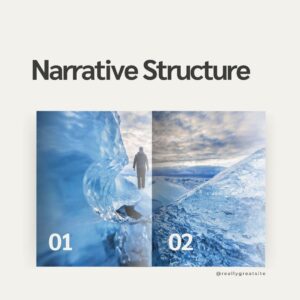Narrative Structure | Definition, Examples, and Writing Tips
Narrative structure is the backbone of any story, providing the framework that shapes how a narrative unfolds. It encompasses the sequence of events, character development, and thematic elements that come together to create a compelling tale. Whether you’re an aspiring author or a reader looking to deepen your understanding of literature, this guide will explore the intricacies of narrative structure, its importance, and how to effectively utilize it in storytelling.

Table of Contents
What is Narrative Structure?
Narrative structure refers to the organized framework that dictates how a story is told. It encompasses the arrangement of events, the development of characters, and the unfolding of themes throughout the narrative. Essentially, it is how the plot is structured and presented to the audience, influencing their understanding and emotional engagement with the story.
Key Characteristics:
- Organization: The way events are sequenced.
- Cohesion: How well different elements of the story connect.
- Flow: The pacing and rhythm of the narrative.
The Importance of Narrative Structure
Narrative structure plays a vital role in storytelling for several reasons:
- Guides Reader Engagement: A well-defined structure keeps readers interested and invested in the story.
- Enhances Emotional Impact: The arrangement of events can heighten emotional responses, making key moments more impactful.
- Facilitates Understanding: A clear structure helps readers follow the plot and understand character motivations and themes.
Key Elements of Narrative Structure
Plot
The plot is the sequence of events that make up a story, guiding readers from beginning to end. A well-crafted plot typically includes:
- Exposition: Introduces characters, setting, and initial situation.
- Rising Action: Builds tension through a series of events leading to the climax.
- Climax: The turning point or moment of highest tension.
- Falling Action: Events that follow the climax leading toward resolution.
- Resolution: The conclusion where conflicts are resolved.
Setting
The setting provides the time and place where the story occurs, establishing context for characters and events.
Characters
Characters are essential for driving the plot forward and engaging readers emotionally. Their development throughout the narrative is crucial for creating depth.
Conflict
Conflict is what drives the plot; it can be internal (within a character) or external (between characters or against larger forces). It creates tension and propels characters toward change.
Theme
The theme is the underlying message or central idea explored in a story, often revealed through characters’ experiences and conflicts.
Types of Narrative Structures
Linear Narrative Structure
In a linear narrative structure, events are presented in chronological order, allowing readers to follow the story as it unfolds naturally.
Non-linear Narrative Structure
A non-linear narrative presents events out of chronological order, often using flashbacks or multiple perspectives to create complexity and intrigue.
Circular Narrative Structure
In a circular narrative, the story ends where it began, emphasizing themes of fate or inevitability while showcasing character growth through their experiences.
Parallel Narrative Structure
Parallel narratives follow multiple storylines that are interconnected through themes or characters, providing depth and richness to the overall narrative.
Common Narrative Structures in Literature
Three-Act Structure
This classic structure divides stories into three parts:
- Setup: Introduces characters and conflict.
- Confrontation: Develops rising action leading to climax.
- Resolution: Resolves conflicts and concludes character arcs.
Freytag’s Pyramid
Freytag’s Pyramid outlines five stages:
- Exposition
- Rising Action
- Climax
- Falling Action
- Resolution
This model helps writers visualize how tension builds throughout a story.
The Hero’s Journey
Joseph Campbell’s concept outlines a common narrative arc found in many myths and stories:
- Call to Adventure
- Crossing the Threshold
- Trials and Challenges
- Return with New Knowledge
The Fichtean Curve
This structure emphasizes rising tension with frequent climaxes leading up to a final resolution, creating an engaging rhythm for readers.
How to Create a Strong Narrative Structure
To craft an effective narrative structure:
- Outline Your Plot: Create a detailed outline that includes all key events and character developments.
- Identify Themes: Determine what themes you want to explore through your narrative.
- Develop Characters: Ensure your characters have clear motivations that align with your plot.
- Maintain Pacing: Balance action with quieter moments to keep readers engaged without overwhelming them.
Examples of Effective Narrative Structures in Literature and Film
- “Pride and Prejudice” by Jane Austen
- Utilizes a linear narrative structure with clear exposition, rising action, climax, falling action, and resolution centered around Elizabeth Bennet’s journey.
- “The Great Gatsby” by F. Scott Fitzgerald
- Employs non-linear elements as Nick Carraway reflects on past events while revealing Gatsby’s tragic story.
- “Inception” directed by Christopher Nolan
- Features parallel narratives as multiple layers of dreams intertwine, creating complex storytelling that challenges viewers’ perceptions.
Common Mistakes to Avoid in Narrative Structure
- Neglecting Character Development: Ensure that characters evolve alongside plot progression; flat characters can weaken your narrative impact.
- Overcomplicating Plotlines: Avoid convoluted plots that confuse readers; clarity is key.
- Ignoring Pacing: Balance high-tension moments with quieter scenes; poor pacing can disengage readers.
FAQs
What is narrative structure?
Narrative structure refers to the organized framework that dictates how a story is told. It encompasses the sequence of events, character development, and thematic elements that come together to create a cohesive narrative.
Why is narrative structure important in storytelling?
Narrative structure is crucial because it helps guide reader engagement, enhances emotional impact, and facilitates understanding of the plot and characters. A well-defined structure keeps readers invested in the story.
What are the key elements of narrative structure?
The key elements include:
- Plot: The sequence of events in the story.
- Setting: The time and place where the story occurs.
- Characters: The individuals involved in the narrative.
- Conflict: The central struggle or challenge faced by characters.
- Theme: The underlying message or idea explored in the story.
What are some common types of narrative structures?
Common types of narrative structures include:
- Linear Narrative: Events are presented in chronological order.
- Non-linear Narrative: Events are presented out of chronological order, often using flashbacks.
- Circular Narrative: The story ends where it began, emphasizing themes of fate or inevitability.
- Parallel Narrative: Multiple interconnected storylines that enhance the overall narrative.
What is the Three-Act Structure?
The Three-Act Structure is a classic storytelling framework that divides a narrative into three parts:
- Setup: Introduces characters and conflict.
- Confrontation: Develops rising action leading to climax.
- Resolution: Resolves conflicts and concludes character arcs.
How can I create a strong narrative structure for my writing?
To create a strong narrative structure:
- Outline your plot with key events and character developments.
- Identify themes you want to explore.
- Develop well-rounded characters with clear motivations.
- Maintain pacing by balancing action with quieter moments.
What are some common mistakes to avoid when working on narrative structure?
Common mistakes include:
- Neglecting character development, which can weaken the plot.
- Overcomplicating the storyline, leading to confusion for readers.
- Ignoring pacing, which can disengage readers if not balanced properly.
Can I mix different narrative structures in one story?
Yes, mixing different narrative structures can add complexity and depth to your story. However, it’s important to maintain clarity so that readers can follow the plot without confusion.
How do I know if my narrative structure is effective?
An effective narrative structure should engage readers, evoke emotional responses, and provide a clear understanding of character motivations and themes. Feedback from beta readers or writing groups can also help assess its effectiveness.
Where can I find examples of effective narrative structures?
You can find examples in various literary works and films. Classic novels like “Pride and Prejudice” or modern films like “Inception” showcase different narrative structures effectively.
Conclusion
Narrative structure is an essential element of storytelling that shapes how stories are told and experienced by readers and audiences alike. By understanding its components—plot, setting, characters, conflict, and theme—and exploring different types of structures, writers can create compelling narratives that resonate deeply with their audience.As you embark on your writing journey, remember that mastering narrative structure requires practice and experimentation; don’t hesitate to try different approaches until you find what works best for your unique voice! Happy writing!




